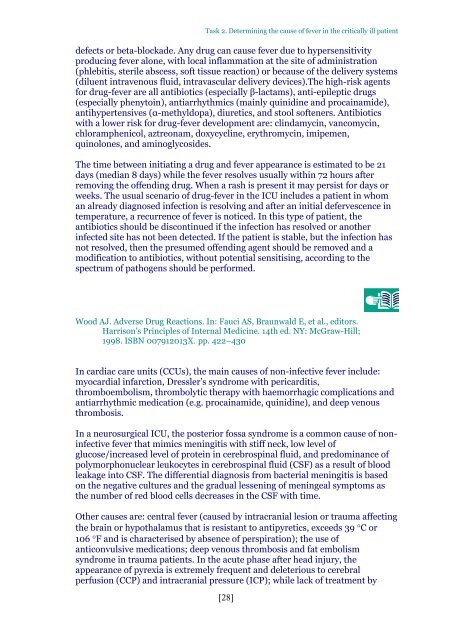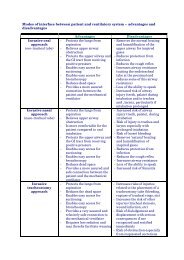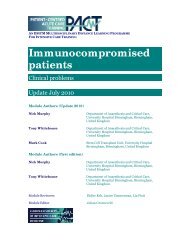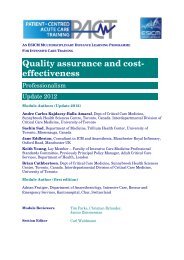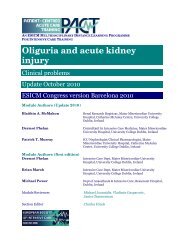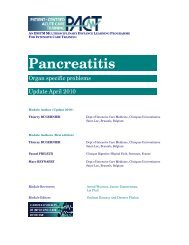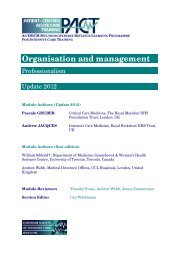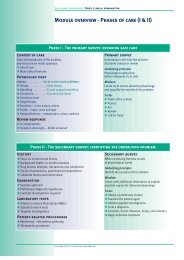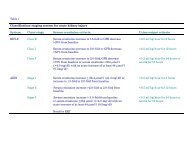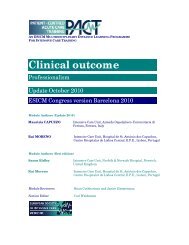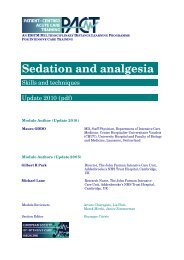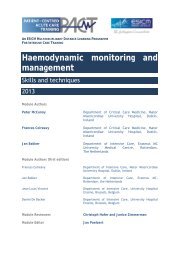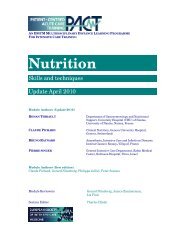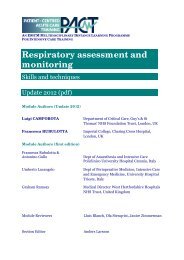Pyrexia - PACT - ESICM
Pyrexia - PACT - ESICM
Pyrexia - PACT - ESICM
You also want an ePaper? Increase the reach of your titles
YUMPU automatically turns print PDFs into web optimized ePapers that Google loves.
Task 2. Determining the cause of fever in the critically ill patient<br />
defects or beta-blockade. Any drug can cause fever due to hypersensitivity<br />
producing fever alone, with local inflammation at the site of administration<br />
(phlebitis, sterile abscess, soft tissue reaction) or because of the delivery systems<br />
(diluent intravenous fluid, intravascular delivery devices).The high-risk agents<br />
for drug-fever are all antibiotics (especially β-lactams), anti-epileptic drugs<br />
(especially phenytoin), antiarrhythmics (mainly quinidine and procainamide),<br />
antihypertensives (α-methyldopa), diuretics, and stool softeners. Antibiotics<br />
with a lower risk for drug-fever development are: clindamycin, vancomycin,<br />
chloramphenicol, aztreonam, doxycycline, erythromycin, imipemen,<br />
quinolones, and aminoglycosides.<br />
The time between initiating a drug and fever appearance is estimated to be 21<br />
days (median 8 days) while the fever resolves usually within 72 hours after<br />
removing the offending drug. When a rash is present it may persist for days or<br />
weeks. The usual scenario of drug-fever in the ICU includes a patient in whom<br />
an already diagnosed infection is resolving and after an initial defervescence in<br />
temperature, a recurrence of fever is noticed. In this type of patient, the<br />
antibiotics should be discontinued if the infection has resolved or another<br />
infected site has not been detected. If the patient is stable, but the infection has<br />
not resolved, then the presumed offending agent should be removed and a<br />
modification to antibiotics, without potential sensitising, according to the<br />
spectrum of pathogens should be performed.<br />
Wood AJ. Adverse Drug Reactions. In: Fauci AS, Braunwald E, et al., editors.<br />
Harrison’s Principles of Internal Medicine. 14th ed. NY: McGraw-Hill;<br />
1998. ISBN 007912013X. pp. 422–430<br />
In cardiac care units (CCUs), the main causes of non-infective fever include:<br />
myocardial infarction, Dressler’s syndrome with pericarditis,<br />
thromboembolism, thrombolytic therapy with haemorrhagic complications and<br />
antiarrhythmic medication (e.g. procainamide, quinidine), and deep venous<br />
thrombosis.<br />
In a neurosurgical ICU, the posterior fossa syndrome is a common cause of noninfective<br />
fever that mimics meningitis with stiff neck, low level of<br />
glucose/increased level of protein in cerebrospinal fluid, and predominance of<br />
polymorphonuclear leukocytes in cerebrospinal fluid (CSF) as a result of blood<br />
leakage into CSF. The differential diagnosis from bacterial meningitis is based<br />
on the negative cultures and the gradual lessening of meningeal symptoms as<br />
the number of red blood cells decreases in the CSF with time.<br />
Other causes are: central fever (caused by intracranial lesion or trauma affecting<br />
the brain or hypothalamus that is resistant to antipyretics, exceeds 39 C or<br />
106 F and is characterised by absence of perspiration); the use of<br />
anticonvulsive medications; deep venous thrombosis and fat embolism<br />
syndrome in trauma patients. In the acute phase after head injury, the<br />
appearance of pyrexia is extremely frequent and deleterious to cerebral<br />
perfusion (CCP) and intracranial pressure (ICP); while lack of treatment by<br />
[28]


